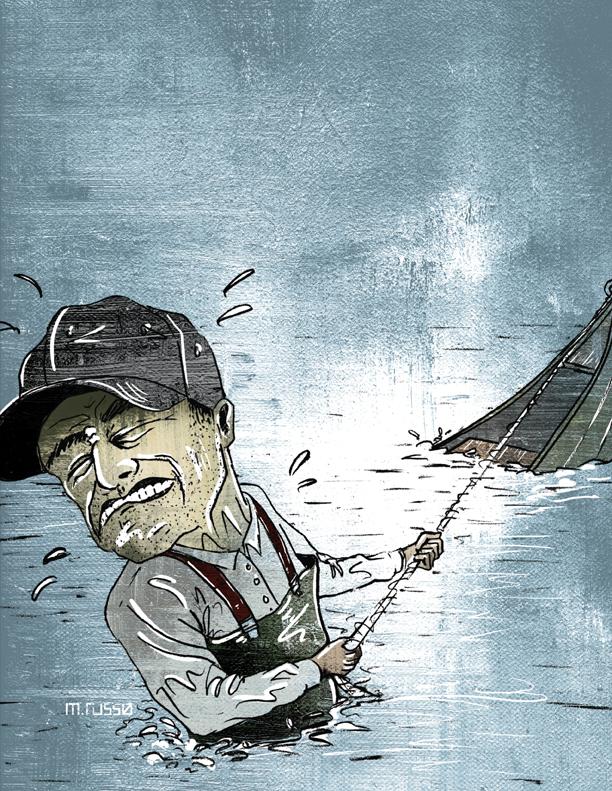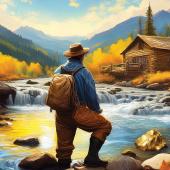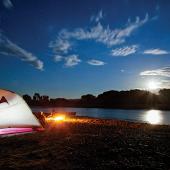Trapper's Run
Mishap on the Madison.
It all took place within seconds. Entering a bend in a fast chute of water, the current grabbed the canoe, slammed it into the bank, and started pulling us down. Water poured over the gunnels as the pressure held us tight to the bank. The nose of the canoe had jammed against a beaver lodge, wedging us in. We were helpless, sinking lower by the second. I knew the heavily loaded canoe was doomed to sink.
I chucked my rifle and backpack to the bank, grabbed the stern line, and slipped overboard. Wading through chest-deep water of the Madison River, I made my way upstream to an overhanging ash tree. While I tied the line to a branch, I yelled to Randy to jump for the beaver lodge. My nine-year-old son, standing on his seat, bent his knees and jumped clear. I waded back down to the canoe and frantically grabbed beaver, mink, and muskrats from inside the boat. The powerful current turned the canoe sideways, dumping my traps into the water. Then it sunk to the bottom.
Born and raised a half-mile from the Gallatin River, where I’d spent countless hours fishing, hunting, and swimming, I was no stranger to rivers and their currents. I’d even seen a drift boat completely crushed by water pressure in the Big Hole. The sinking canoe had put me into survival mode; I seemed to be running as though automated. But with my son safe, it was time to see about saving my canoe.
The year was 1969. We were about two miles downstream from Ennis, in one of the many channels the Madison breaks into as it flows north toward Ennis Lake. It was a sunny November day; a bit cool, but not what one would call cold. I sized up the situation: although the current was coming hard into the bend, where the canoe was stuck, it was flowing much harder around the beaver lodge. I figured this faster water might work to my advantage.
I untied the rope and waded to the opposite bank, where I dug in my heels and leaned hard into the rope. The canoe was heavy, like a sunken log, but with some effort I got it to move. Eventually I pulled it out far enough where the current got behind it and kicked it into the faster water around the beaver lodge. I pulled harder and it came free. The current swept it slowly downstream to a shallow riffle, where it stopped. I dumped the water, got it back upright, and tied it to a small aspen. The canoe was undamaged.
Randy kept his perch on the beaver lodge. I walked back upstream and asked him if he was all right. “My feet are soaked, Dad, ” he said, “but I’m okay.” “Good,” I told him, “now let’s get this gear and critters back to the canoe.”
After we loaded everything, I explained to Randy why we had wrecked, how the weight in the canoe and the current movement was a bad combination. I also explained how I was able to get the canoe out. I then told him that with his wet feet, the best thing would be to drop him off at the Hubners, some friends who lived downstream. I would then finish the run on my own.
We got in the canoe and shoved off, checking traps as we went. When we were near the Hubners’s place, I beached the canoe and walked Randy to their house. They were more than happy to take Randy in, and of course he had a delightful time telling them all that happened.
As I walked back to the river, thoughts came rushing into my mind. First, I thanked our maker that Randy was all right. Then I mused on what the river had taught me. I settled on this: don’t take chances when you’re not sure of the outcome. I knew that this river did not have a great conscience and would drown me in a minute. I also knew I could have beached the canoe and walked it past that fast run. And I knew that I needed to buy Randy a pair of hip boots, to replace the snow-pacs he had on.
Mainly, though, what I felt was gratitude—what could have been a real heart-tearing run had turned out okay. I liked the life I had, and worked hard at keeping it that way. In the spring and fall I worked for the Forest Service, but there wasn’t much for decent employment in Ennis, Montana during the winter. With the high demand in the European fur market, trapping was a good way for me to keep my family and help pay the bills. I could have lost my canoe and all my traps, and all that extra income.
But I hadn’t. As I reached the river, I paused a moment to take in the canoe sitting there with all the trapping gear. “Well,” I said, “did you enjoy your baptism?” It was a 16-foot Starcraft with a three-foot beam—a trapper’s dream as far as I was concerned. (My previous “canoe” was a 12-foot homemade unit, covered in canvas with waterproof paint—and with it there is another story.)
I launched the canoe and headed on downriver. The beauty of this run was almost intoxicating, with the large cottonwood trees, red willows, and pods of cattails everywhere. There was life all around me: red-winged blackbirds, Canadian geese, red-tailed hawks, various kinds of ducks, and numerous other songbirds. I marveled at the diversity of nature and the beauty it spreads all over the world. Just like the beauty in all the people I’ve met, it all lays right there in my memory.
I took a beaver, two muskrats, and a mink before reaching the spot where the Madison empties into Ennis Lake. I could see my old red pickup truck about a thousand yards away, near the northwest corner of the lake. I headed across, thankful that the wind wasn’t blowing; otherwise I’d have had to skirt the edge of the lake which would take much longer.
I made the same run the next morning, using a grappling hook and rope to retrieve my tub and traps. As I loaded up the truck, I realized my respect for rivers had taken a high climb, and that I felt very close to the Madison. I put the truck into gear, picked up Randy, and then headed home to start skinning and stretching fur.










